
Calabria was a small protected cruiser of the Italian Regia Marina which was to serve across the growing Italian empire. Construction took six years, and she was armed with four 6-in main guns, four 4.7 in guns with the size and displacement of a typical large gunboat. She saw a lot of naval mileage, being assigned to stations in China, North American and Australian waters, in addition to East Africa and the Mediterranean, seeing action in the Italo-Turkish War and reclassified as a gunboat in 1921, then training ship in 1924.
Design of the class
Calabria was a protected cruiser designed by naval engineer Edoardo Masdea, part of the “Regioni” superclass also comprising the classes Elba, Lombardy, Umbria, Etruria, Liguria and Puglia. However, she differed from the others by having three masts and single funnel, looking like more of a gunboat than a regular cruiser.
Hull and general design
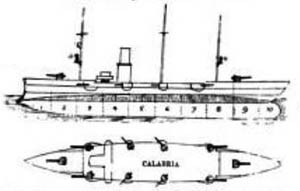
The choice of three shorter masts could have been dictated by the need of easier rigging management, but photos shows an improper set of two Yards (fore and mainmast) and three spanker heads. But this was in 1890. The rigging was never installed if ever intended, and the masts were transformed into proper military masts anyway around 1905. The foremast in its original form carried two tops, oa projector platform and a spotting platform above, barely at the level of the funnel top.
Edoardo Masdea plan to have her using a steel hull sheathed with wood and zinc to “tropicalize” the hull from fouling, during lengthy stays far away stations in mostly tropical conditions. She was to be serviceable with minium maintenance and quasi-absent or limited shipyard facilities, and so capable of long periods without proper overhauls. For a cruiser, even for 1890, she was small and “stubby”, with a 76 meters (249 ft 4 in) long hull long between perpendiculars, 81 m (265 ft 9 in) overall combined with a beam of 12.71 m (41 ft 8 in) making for a 6.2 ratio.
She had an important draft of 5.05 m (16 ft 7 in) so allowing only limited inlets, bays and rivers (like the Yangtze).
Normal displacement was 2,453 long tons (2,492 t) and reaching 2,660 long tons (2,700 t) fully loaded. Her design included a flush deck and ram bow with minimalistic superstructures: Apart a small conning tower aft of the forward barbette, a small bridge platform above, another aft, she had three pole masts with planned rigging, but mostly intended for signalling and spotting. The central section of the structure, around the single round funnel, comprised pathways and air intakes, as well as 8 service boats mostly on davits, and she carried a crew of 214-254 officers and ratings.
Armour protection layout
Armor protection was limited, to the level of a protected cruiser. It consisted of a curved 50 mm (2 in) thick deck sloping downward on each sides to offer a slope to incoming fire. There was no proper armor belt. Her conning tower had walls 50 mm thick with steel plating, enough to top shell fragments up to a medium calibre round. The ASW compartmentation alongside the machinery space comprised ten sections, but no armoured walls, nothing which would have resisted a heavy torpedo impact on WWI. It is likely these sections were filled with coal as customary at the time, up to waterline level, with extra compartments above the armoured turtle deck.
Powerplant
Calabria was given by two vertical triple-expansion steam engines driving each a propeller shaft. They were fed by steam supplied by four coal-fired and cylindrical fire-tube boilers. In turn, these were exhausted into a truncated single funnel located amidships behind the bridge and conning tower. Total output on trials was 4,260 indicated horsepower (ihp) or 3,180 kW. This enabled a top speed of 16.4 knots (30.4 km/h; 18.9 mph). Let’s remind here that the Garibaldi class, a couple of years later and definitely better protected, were capable of 20 knots. Calabria however had sufficient range for its intended role, at 2,500 nautical miles (4,600 km; 2,900 mi) while cruising at 10 knots (19 km/h; 12 mph). Although a sailing rig was planned, it was never installed, given its absence on the rare photos of the ship.
Armament
Calabria was armed with a mix of “secondary guns” heavy and medium fast cannons of neighbouring calibre, making in firepower what she lacked in range. Her two torpedo tubes were the only reason she was classed as a “torpedo ram” in the first place.
Main
Calabria’s main battery comprised four 15 cm (5.9 in) L/40 guns. They were located fore and aft of the deck, in the axis, and two on sponsons forward, to have three in chase but two in retreat, their arc of fire was limited rearwards. The guns were British QF 6-inch 40 calibre naval guns, from Elswick Ordnance Company manufactured at the Elswick Ordnance Company Royal Arsenal, Woolwich.
They fire a 100 pounds (45 kg) QF, separate cartridge and shell round, the mount elevated and depressed to -5/+20 degrees, ROF was 5-7 rpm, Muzzle velocity 2,154 feet per second (657 m/s) and effective 10,000 yards (9,140 m) at 20° elevation.
Secondary
The secondary battery comprised four 12 cm (4.7 in) L/40 guns, all mounted individually on side sponsons, amidship along the hull. These were also classic Elswick guns designed in 1885, QF 4.7-inch Mk.II (presumably), which used Separate loading AP and HE 45 pounds (20.41 kg) rounds. The gun used a single motion interrupted screw breech, with 12 inches (305 mm) recoil. The mount elevated and depressed to -6° – 20°, ROF 5–6 rpm, Muzzle velocity 1,786 fps (544 m/s) with gunpowder or 2,150 feet per second (660 m/s) with cordite bags. Max range was about the same as the main guns at 10,000 yards (9,100 m) at 20°. So they had the same range and rate of fire. An average broadside volley was five shells strong every ten seconds…
Tertiary
Light armament for close-range defence against torpedo boats comprised eight 5.7 cm (2.2 in) L/40 Hotchkiss guns. They were located along the weather deck and protected by shields just thick enough to stop light fire and shrapnel, four either side. These were capable of 25 rpm (mv 1,818 fps) and also 10,000 yds, but 4,000 (3,700 m) effective.
This was complemented by eight 3.7 cm (1.5 in) L/20 guns which type and location are unknown. This was complemented by a pair of machine guns, likely liquid-cooled Maxim type. They could have been dismounted to be placed on the steam cutters to cover and landing party, also a part of colonial duties in case of insurrections.
Torpedo Tubes
Calabria was also equipped with a pair of 450 mm (17.7 in) torpedo tubes, likely underwater and broadside. The torpedo type was probably the Siluranti B57 (Schwarzkopff & Rijeka, 1888). Provision is unknown.
Upgrades
In 1914, she had still her four 152mm/40 maintained, all 4.7-in guns removed (two more modern added) also and two single QF 57mm/40 (Two 5.7 cm guns, six of the 3.7 cm removed).
In 1921 when used as a training ship, she had her two 450mm TTs removed, a single 152mm/40 A1891 kept, two single 57mm/40 kept, but a single 40mm/39 M1917 added.
⚙ Calabria specifications |
|
| Displacement | 2,453 long tons standard, 2,660 long tons FL |
| Dimensions | 81 x 12.71 x 5.05 m (265 ft 9 in x 41 ft 8 in x 16 ft 7 in) |
| Propulsion | 2 shaft TE, 4 FT boilers 4,260 ihp (3,180 kW) |
| Speed | 16.4 knots (30.4 km/h; 18.9 mph) |
| Range | 2,500 nmi (4,600 km; 2,900 mi) at 10 knots |
| Armament | 4× 15 cm, 4× 12 cm, 8× 5.7 cm, 8× 3.7 cm, 2× 450 mm TT |
| Protection | Turtledeck 50 mm (2 in), Conning tower 50 mm |
| Crew | 214–254 |
Good Gunboat, Poor cruiser design
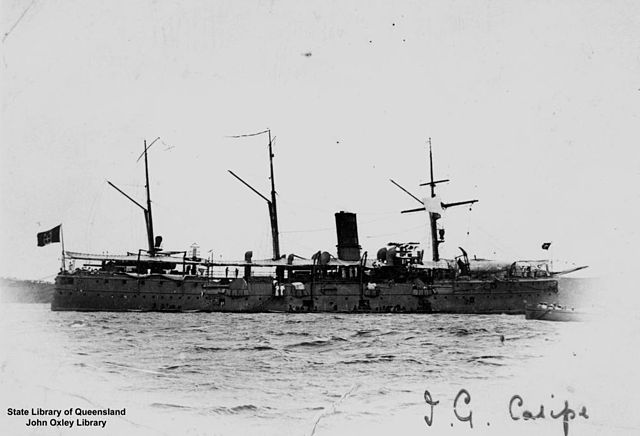
Calabria, date unknown, prewar, Stae Library of Queensland Australia. Note this is one of the very rare photo showing a semblance of rigging, with folded spanker sails.
Calabria was built in the Military Maritime Arsenal of La Spezia. Her hull was laid down on 22 September 1890. She was officially classified as a “torpedo boat ram” (ariete torpediniere) when launched on 20 September 1894, and then again reclassified as a “protected cruiser” (incrociatore protetto) and after being completed in 1897 she entered service on 21 July 1897.
Her career was colourful: She took part in an expedition to China during the Boxer Rebellion, with a landing party retaking the Taku forts. She served in the Caribbean, Atlantic, Pacific (Tuamotu, Marshall), Shanghai and made two more world trips before taking part in the Italo-Turkish war in 1911, from the Red Sea, using her guns for coastal bombardment. In 1914 she protected Italian interest during the Mexican Revolution and from 1915 patrolled off Eastern Africa (24 missions). Postwar she returned to the Far East and back home was replaced in 1924 by the cruiser Libya (herself was classified as a gunboat).
Initially, this type of small cruiser had little success, lacking protection and being slow. However she was still able to show it’s excellent agility and seaworthiness in difficult weather and heavy seas, having great stability due to the low lenght-weight ratio. This favored artillery accuracy in her posting role of “quasi-gunboat”. This armament was modified several times in 1905, 1914 and 1921 and her size and speed made her reclassified logically as a “gunboat” (cannoniera). Despite this, she went on in service as a far from home TS until the mid-1920s which was not bad for a ship designed in 1890.
Calabria’s 24 years career (1897-1924)
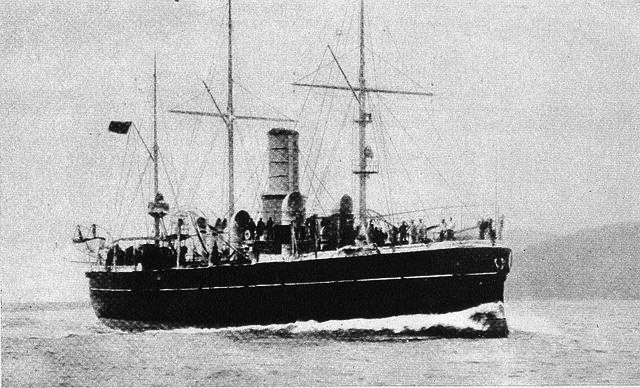
Calabria as completed, 1897 to 1900.
Calabrian was built at La Spezia dockyard, laid down in February 1892, launched on 20 September 1894, fitted-out work completed by mid-1897. She was commissioned on 12 July. Part of the Reserve Division (ironclads Lepanto, Italia, Duilio, Francesco Morosini, Ruggiero di Lauria) with the protected cruiser Lombardia, torpedo cruiser Calatafimi, two torpedo boats she started training until prepared for her first overseas deployment.
Calabria’s first mission was to show the flag during a crisis on Crete that could spread into the eastern Mediterranean, with the Ottoman Empire in high tension. In 1898, the Spanish-American War saw her redeployed in the Caribbean until the end of the conflict. She safeguarded Italian trade and her own citizen’s interests in Cuba. Back home after a refit she started the first of many, long overseas deployments marking her first decade. She was in Chinese waters in 1899 as the Boxer Uprising started and soon joined an international squadron (“Eight Nation Alliance”). She entered the mouth of the Hai River carrying a contingent of 475 Italian Marine Rifles, which were landed and travelled to Beijing in order to reinforce the Legation Quarter. She landed her own party also to retake the Taku forts which protect the entrance of the Peiho (Hai river).
Back home after another upkeep, she was sent on 20 May 1902 to Cuba, which was granted its independence from the US and found there the British protected cruiser HMS Psyche. Both fired salutes to USS Brooklyn. In April 1903, Calabria was in Kobe, Japan, as part of her far east station. She took part in a naval review in presence of Japanese Emperor Meiji. Also included were the British Battleship HMS Glory and protected cruiser HMS Blenheim, German protected cruiser SMS Hansa, French protected cruiser Pascal, Russian protected cruiser Askold.
Calabria made another long overseas cruise from early 1905 with a midshipman of mark aboard, Prince Ferdinando. She departed Venice on 4 February, fitted with wireless telegraphy for testings. She called Gibraltar, which was a success. Furthermore, she crossed the Atlantic to the West Indies, visiting Santo Domingo (Dominican Republic) for “gunboat diplomacy” as the country developed huge debts from Italian nationals. She went on along the West South American coast, calling Buenos Aires, Rio de Janeiro, Montevideo, Callao and Lima, and rounding the cape, Valparaiso, and finally Acapulco in Mexico.
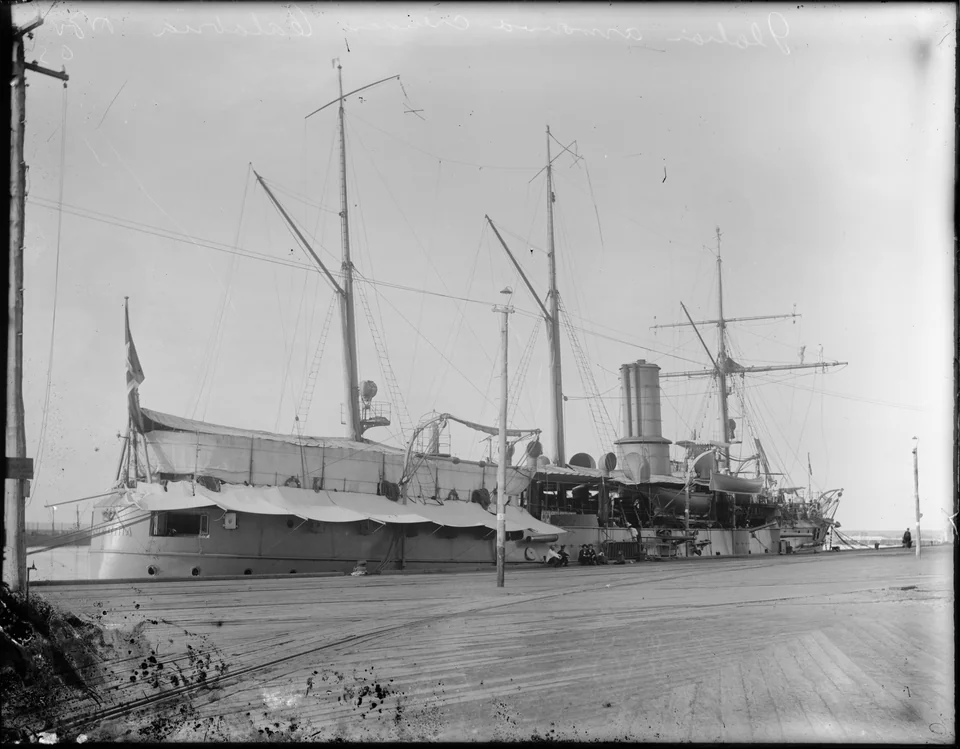
Calabria in white livery, moored at Fremantle, Australia, November 1905 (Reddit)
On 11 September she visited San Francisco and after crew’s leave, she went on with her circumnavigation, heading to Oceania, visiting Australia and several Pacific islands. In May 1906, Calabria was back in Chinese waters. On the 18th, she saluted in Nanking the French cruiser Descartes and German gunboat SMS Vorwärts. By October 1909, she was back on the West Coast, taking part in the Portola Festival of San Francisco (140th anniversary of the Portolà expedition). 1910 was about the same long trip, but not much more is known.
Italo-Turkish War
On 29 September 1911 war was declared between Italia and the Ottoman Empire. The goal was to seize Ottoman Tripolitana (Libya), and the Ottomans made a move to threaten Italian Eritrea by launching an attack across the Red Sea from Arabia. The staff started to support anti-Ottoman rebels in Yemen to free their move to Tripolitana. Calabria was still in the Far East at the time, and received an urgent communication to sail back to the Red Sea via the Indian ocean. She was to reinforce the small naval force in Eritrea.
After arrival, she was soon joined by the cruiser Puglia, and both started bombarding the Turkish port of Aqaba (19 November 1911) and force the contingent to leave. Hostilities ceased when King George V crossed the Red Sea after his coronation ceremony in India. They resumed on 26 November and on the 30th, Calabria and the gunboat Volturno bombarded a quarantine station near Perim and later to Mocha and Cheikh Saïd.
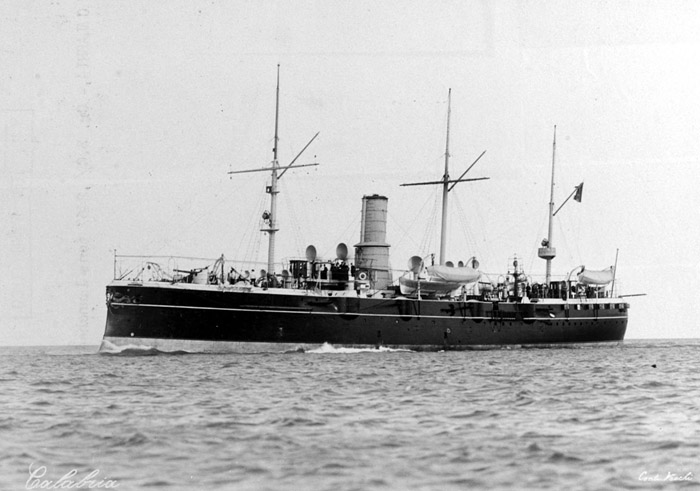
In early 1912, the Italian Red Sea Fleet tried to locate seven Ottoman gunboats which carried contingents to attack Eritrea. They ignored the flotilla never departed due coal shortages. Calabria and Puglia executed several diversionary bombardments: Jebl Tahr, Al Luḩayyah, and with the cruiser Piemonte (escorted by the destroyers Artigliere and Garibaldino) she resumed her search for the Turkish gunboats. On 7 January, they located them and engage the (unequal) fight at the Battle of Kunfuda Bay. Four were sunk, the others so badly damaged they were beached to avoid sinking. On the 8th, the Italian flotilla landed a shore party to finish off the grounded gunboats, now deserted, with explosives. Calabria and the rest of the flotilla were back shelling Turkish ports in the Red Sea which ended with a blockade of Al Hudaydah on 26 January. Calabria, short of coal and ammunition, then was ordered back to Italy in April. Worn-out, she also needed a dry-dock refit and comprehensive overhaul. The war ended in absentia, the Turkish Ottoman Empire accepting surrender terms in October.
WW1 and late career
In 1914, after her overhaul, she had less armament but more modern 12 cm guns and less light guns. This enabled to reduce the crew and overall maintenance costs as well, although she was still classified as a cruiser. She took part in the safeguarding of Italian interests and Citizens in Mexico during the revolution in 1914. In January 1915, while still neutral, Calabria roamed the coast of Ottoman Syria, assisting refugees with the armoured cruiser USS North Carolina. Her records are not known for late 1915 and 1916, she was likely stationed in East Africa.
She was sent in July 1917 for a diplomatic mission, departing Massawa and crossing the Red Sea to visit Hussein bin Ali (auto proclaimed King of Hejaz), to the Mecca and was back to East African waters, in January 1918. She showed the flag off Somalia and visited Aden and Djibouti. The war ended and Calabria was still stationed in East Africa, but sailed back home for a refit, being reclassified as a gunboat in 1921, with her armament curtailed again (since 15 cm gun, two 5.7 cm guns, 4 cm (1.6 in) L/39 autocannon). She was used as a gunboat until early 1924, acting as a gunnery training ship for a few months. Due to her age, she was condemned and discarded, then sold for BU on 13 November 1924.
Read More
Books
Annual Reports of the Navy Department for the Year 1902. Washington, DC
Beehler, William Henry (1913). The History of the Italian-Turkish War. USNA
Cresciani, Gianfranco (2003). The Italians in Australia. Cambridge: Cambridge University Press
Esposito, Gabriele (2020). Armies of the Italian-Turkish War: Conquest of Libya, 1911–1912. Oxford: Osprey.
Fraccaroli, Aldo (1979). “Italy”. In Gardiner, Robert (ed.). Conway’s All the World’s Fighting Ships 1860–1905.
Garbett, H., ed. (June 1897). “Naval Notes—Italy”. Journal of the Royal United Service Institution.
Robinson, C. N. (1912). Hythe, Thomas (ed.). “The Turco-Italian War”. The Naval Annual. Portsmouth: J. Griffin & Co.
Willmott, H. P. (2009). The Last Century of Sea Power. Vol. I: From Port Arthur to Chanak, 1894–1922. Bloomington: Indiana University Press.
Links
on navypedia.org/
en.wikipedia.org/
marina.difesa.it/
it.wikipedia.org
Photo of the launch (De Agostini coll.)


 Latest Facebook Entry -
Latest Facebook Entry -  X(Tweeter) Naval Encyclopedia's deck archive
X(Tweeter) Naval Encyclopedia's deck archive Instagram (@navalencyc)
Instagram (@navalencyc)





 French Navy
French Navy Royal Navy
Royal Navy Russian Navy
Russian Navy Armada Espanola
Armada Espanola Austrian Navy
Austrian Navy K.u.K. Kriegsmarine
K.u.K. Kriegsmarine Dansk Marine
Dansk Marine Nautiko Hellenon
Nautiko Hellenon Koninklije Marine 1870
Koninklije Marine 1870 Marinha do Brasil
Marinha do Brasil Osmanlı Donanması
Osmanlı Donanması Marina Do Peru
Marina Do Peru Marinha do Portugal
Marinha do Portugal Regia Marina 1870
Regia Marina 1870 Nihhon Kaigun 1870
Nihhon Kaigun 1870 Preußische Marine 1870
Preußische Marine 1870 Russkiy Flot 1870
Russkiy Flot 1870 Svenska marinen
Svenska marinen Søværnet
Søværnet Union Navy
Union Navy Confederate Navy
Confederate Navy Armada de Argentina
Armada de Argentina Imperial Chinese Navy
Imperial Chinese Navy Marinha do Portugal
Marinha do Portugal Mexico
Mexico Kaiserliche Marine
Kaiserliche Marine 1898 US Navy
1898 US Navy Sovietskiy Flot
Sovietskiy Flot Royal Canadian Navy
Royal Canadian Navy Royal Australian Navy
Royal Australian Navy RNZN Fleet
RNZN Fleet Chinese Navy 1937
Chinese Navy 1937 Kriegsmarine
Kriegsmarine Chilean Navy
Chilean Navy Danish Navy
Danish Navy Finnish Navy
Finnish Navy Hellenic Navy
Hellenic Navy Polish Navy
Polish Navy Romanian Navy
Romanian Navy Turkish Navy
Turkish Navy Royal Yugoslav Navy
Royal Yugoslav Navy Royal Thai Navy
Royal Thai Navy Minor Navies
Minor Navies Albania
Albania Austria
Austria Belgium
Belgium Columbia
Columbia Costa Rica
Costa Rica Cuba
Cuba Czechoslovakia
Czechoslovakia Dominican Republic
Dominican Republic Haiti
Haiti Hungary
Hungary Honduras
Honduras Estonia
Estonia Iceland
Iceland Eire
Eire Equador
Equador Iran
Iran Iraq
Iraq Latvia
Latvia Liberia
Liberia Lithuania
Lithuania Mandchukuo
Mandchukuo Morocco
Morocco Nicaragua
Nicaragua Persia
Persia San Salvador
San Salvador Sarawak
Sarawak Uruguay
Uruguay Venezuela
Venezuela Zanzibar
Zanzibar Warsaw Pact Navies
Warsaw Pact Navies Bulgaria
Bulgaria Hungary
Hungary

 Bundesmarine
Bundesmarine Dutch Navy
Dutch Navy Hellenic Navy
Hellenic Navy Marina Militare
Marina Militare Yugoslav Navy
Yugoslav Navy Chinese Navy
Chinese Navy Indian Navy
Indian Navy Indonesian Navy
Indonesian Navy JMSDF
JMSDF North Korean Navy
North Korean Navy Pakistani Navy
Pakistani Navy Philippines Navy
Philippines Navy ROKN
ROKN Rep. of Singapore Navy
Rep. of Singapore Navy Taiwanese Navy
Taiwanese Navy IDF Navy
IDF Navy Saudi Navy
Saudi Navy Royal New Zealand Navy
Royal New Zealand Navy Egyptian Navy
Egyptian Navy South African Navy
South African Navy






























 Ukrainian Navy
Ukrainian Navy dbodesign
dbodesign